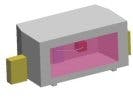Integrated optimization capabilities provide a robust tool for LED backlight design
Times are changing for liquid crystal display (LCD) backlight designers. An old technology is coming of age and creating a myriad of benefits for the end-user, from brighter displays with more vivid colors to longer battery life for portable devices. This technology is the LED. LEDs have been around since the early 1960s but, until recently, have not been useful for LCD backlights because of low luminance and lack of a white spectrum.
There is, however, at least one drawback to using LEDs for LCD backlights: it’s more difficult to design the light guide extraction features. CCFLs are relatively large and linear, which means that their extraction-feature patterns are roughly linear in one dimension. LEDs are small and discrete in nature, so their extraction patterns need to have structure in two dimensions.
This complicates light guide design, which is often done through a tedious and expensive trial-and-error process. A designer lays out a pattern, creates a mockup, tests it, makes modifications based upon the results, and then repeats some of these steps, if necessary. A more practical approach relies on illumination design and analysis software packages, many of which have design and analysis tools that are useful for backlight designers.
+++++++
To read the rest of this article, please register for a free subscription to LEDs Magazine Review.Why?
Existing subscribers:Click here to enter your reader number and download the new issue.
+++++++





